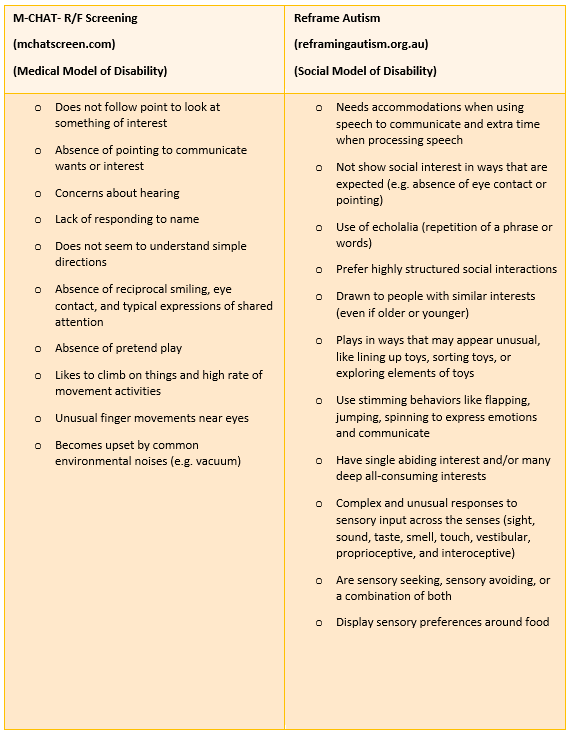What is Autism?
There are at least two models for understanding autism: 1) the social model of disability, and 2) the medical model of disability.
Social Model of Disability: Disability as a natural variation of the human condition deserving of equal access, rights, and opportunities. Social factors such as environment, attitudes, and systems/ institutions as the target of intervention/ change.
Medical Model of Disability: Disability as an impairment/ significant deviation from the normal human expression. Deserving and requiring treatment, intervention, and accommodations in order to ensure equal access, rights, and opportunities.
The Diagnostic and Statistical Manual -V (DSM-V) follows the medical model, and autism is defined as follows:
Persistent deficits that are…
- Present in early development
- Causes significant impairment in functioning
- Not better explained by another disability
3 out of 3 social communication and interaction deficits
- Deficits in social-emotional reciprocity
- Deficits in non-verbal communication
- Deficits in developing, maintaining & understanding relationships
2+ out of 4 restricted, repetitive patterns of behavior, interests, or activities
- Stereotyped or repetitive motor movements, use of objects or speech
- Insistence on sameness, inflexible adherence to routines, ritualized patterns of verbal or nonverbal behavior
- Highly restricted, fixated interests of abnormal intensity or focus
- Hyper or hypo reactivity to sensory input or unusual interest in sensory aspects of environment
Levels of severity
Reframe Autism (reframingautism.org.au) describes autism as a developmental difference in which Autistic people have more qualities and characteristics in common with other Autistic people than with non-Autistic people.
This model highlights primary differences in:
- The ways Autistic people socialize and communicate
- Connect, make, and understand friendships/ relationships
- Use speech and body language
- The ways Autistic people think and process
- See patterns and connections
- Imagine and play
- Experience and express senses
- Emotions and executive functioning
- Brain development
- Dynamic expression of functioning across domains such as executive functioning, communication, relationships, emotional intensity; influenced by environment and individual circumstances
Signs of Autism in Childhood
Co-Occurring Conditions
Several medical or psychiatric conditions occur alongside autism. These are called co-occurring conditions. Nearly three-quarters of autistic children are diagnosed with a co-occurring condition.
Co-occurring conditions can appear at any time during a child’s development, and it is important to identify and diagnose the conditions and manage them separately.
- 40-60% of Autistic children also have anxiety.
- 30-80% of Autistic children meet the criteria for an ADHD diagnosis.
- Research has shown that people with certain types of eating disorders are more likely to be Autistic than people without eating disorders.
- About 80% of Autistic children have some form of motor difficulty.
- 20-30% of Autistic people have epilepsy. Seizures are most common in children under 5 years and in teenagers.
- About 5% of Autistic children have Tourette syndrome and another 9-12% have tics of some kind.
https://raisingchildren.net.au/autism/learning-about-autism/about-autism/conditions-that-occur-with-asd
- Around 31% of people with a diagnosis of autism also have an intellectual impairment..
- Around 29% of people on the autism spectrum have skills that are considered exceptional, including their ability to remember and recall information, to draw using incredible detail, or to produce music that is pitch perfect.
https://thespectrum.org.au/autism-diagnosis/related-conditions/
World Health Organization (WHO)
All people, including people with autism, have the right to the enjoyment of the highest attainable standard of physical and mental health.
And yet, autistic people are often subject to stigma and discrimination, including unjust deprivation of health care, education, and opportunities to engage and participate in their communities.
Prevalence (cdc.org)
- About 1 in 36 children has been identified with autism spectrum disorder (ASD)
- ASD is reported to occur in all racial, ethnic, and socioeconomic groups. *
- ASD diagnoses are nearly 4 times more common among boys than among girls. **
- *Minority groups experience systemic barriers to information about, identification of, and access to services for autism.
** Presentation of autism in females is under-studied and under-diagnosed.
ABC of NC provides a range of therapeutic and educational services recommended for/ entitled to people with autism in a neurodiversity affirming environment.
ABC of NC also educates and advocates within the community to change attitudes, provide environmental supports, and improve institutional practices to better understand, include and embrace autistic individuals.



